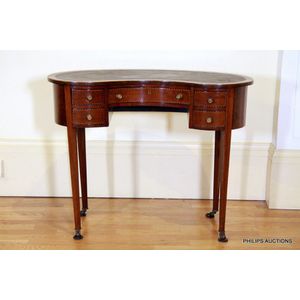Antique Mahogany Kidney Shaped Desk with Leather Top
You must be a subscriber, and be logged in to view price and dealer details.
Subscribe Now to view actual auction price for this item
When you subscribe, you have the option of setting the currency in which to display prices to $Au, $US, $NZ or Stg.
- Ebony - Ebony is a close grained timber, black in colour. It has a fine texture which can be polished to a high gloss, making it suitable for venereering, inlay and stringing and its use as solid timber is resticted to small decorative items and ornamental decoration, such as chess pieces and musical instrument parts. The term "ebonised" means "faux ebony", timber that has been darkened during the polishing process to resemble ebony.
- Blind Tooling / Blind Tooled - Blind tooling is a technique used in the decoration of leather goods such as book covers, belts, and wallets. It involves the use of specialized tools to impress designs and patterns onto the surface of the leather without the use of added colour.
The process involves the use of a variety of tools, including stamps, embossing tools, and finishing tools, which are used to create various textures and patterns on the leather surface. The tools are heated, and then pressed onto the leather, leaving an impression. The tools can be used to create designs that are simple or complex, with a variety of textures and patterns, including geometric shapes, florals, or scenes. The leather is then burnished to enhance the design and give it a smooth finish. - Boxwood - Boxwood is a hard, yellow coloured, close grained timber. In the 19th century it was often used for inlays, especially stringing, because of its contrasting colour to the darker timbers of the carcase. Stringing is the inlay of a narrow strip of veneer of a lighter colour, such as boxwood along or close to the edges of an object that has been veneered in a darker timber such as mahogany.
Because of its fine grain and resistnce to splitting or chipping it has also been used for treen, turnings, carvings and other small wooden items, such as chess pieces. - Tooled - Decoration of a leather surface, usually by stamping the surface with a heated punch or wheel containing foliate or geometric designs. In blind tooling the surface of the punch or wheel is in direct contact with the leather, while in gold tooling, a ribbon of gold leaf is placed between the punch or wheel and the leather, and once they have been applied, the excess gold is brushed off, leaving only the design.
- Mahogany - Mahogany is a dense, close grained red-coloured timber from the West Indies and Central America. It was first imported into Europe in the the early 18th century and its use continued through the 19th century. It was popular for furniture making because of its strength, the wide boards available, the distinctive grain on some boards, termed flame mahogany and the rich warm colour of the timber when it was polished.. The "flame" was produced where a limb grew out from the trunk of the tree, and this timber was usually sliced into veneers for feature panels on doors, backs and cornices.
Some terms used to describe mahogany relate to the country from which it originally came, such as "Cuban" mahogany, "Honduras" mahogany etc. However unless the wood has been tested the names assigned are more a selling feature, rather than a true indication of the timber's origin. - Circa - A Latin term meaning 'about', often used in the antique trade to give an approximate date for the piece, usually considered to be five years on either side of the circa year. Thus, circa 1900 means the piece was made about 1900, probably between 1895 and 1905. The expression is sometimes abbreviated to c.1900.
- Stringing - Fine inlaid lines, in contrasting colour to the carcase timber, found mainly on furniture made in the styles of the later 18th and early 19th centuries. Stringing, which may be of satinwood, pine, ebony, horn, brass or occasionally ivory, is found principally on drawer fronts, around the outer edges of usually tapered legs and French bracket feet, around the edges of inlaid panels and between the joint of the cross banding and carcase timber on table tops, chests of drawers, cabinets etc. The effect is to emphasize the line of the piece and add to the impression of lightness and elegance. Stringing also occurs in Sheraton-revival-style furniture of the later 19th and early 20th centuries.
This item has been included into following indexes:
- desks, period or age - Victorian 409
-
desks, style or type
- kidney shaped 23
- table style 191
Visually similar items

An English mahogany Sheraton Revival hall table, circa 1900. The rectangular table of serpentine profile with a book end veneer and cross banded top above a fluted frieze drawer centred with a relief carved urn and swag embellishment, raised on long slende

A Georgian half round mahogany hall table, early 19th century, the table with a square edged top above a single frieze drawer with a pair of cast brass ring pull handles and plates, raised on square section tapering legs. Height 75 cm, width 129 cm, depth

A Regency mahogany fold-over card table, 73 cm high, 91.5 cm wide, 45 cm deep

An Edwardian walnut kidney shaped desk with three leather inset panels raised on turned and fluted legs with brass casters. Height 79 cm. Width 182 cm. Depth 76 cm
